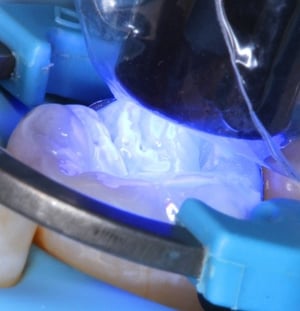Louis Mackenzie, provides the second of a two-part update on light curing.
Louis Mackenzie: Head of Clinical Training at SimplyHealth Professionals
 Louis Mackenzie is a GDP working in Birmingham and is a clinical lecturer at the University of Birmingham School of dentistry and in the postgraduate department at King’s college London.
Louis Mackenzie is a GDP working in Birmingham and is a clinical lecturer at the University of Birmingham School of dentistry and in the postgraduate department at King’s college London.
He delivers lectures nationally and internationally on direct and indirect restorative techniques, minimally invasive dentistry and clinical photography and runs a series of popular hands-on courses.
He is a member of the editorial board of Dental Update journal, is the head of clinical training at SimplyHealth Professionals and is academic lead of the University of Birmingham’s Master’s programme in Restorative Dentistry.
Introduction
Having provided an overview of selection criteria for light curing units (LCUs) in part one, this blog focuses on operator technique, which has a significant effect on the radiant exposure delivered to resin-based composite materials.1,2 The serious hazard posed to the eyesight of dental team members is also discussed, along with protocols for decontamination and maintenance.
Light Curing Technique
When light curing, the generally accepted guidelines listed below should be followed:1,2
 The light tip should be placed as close and as perpendicular to the restoration surface as possible. Pictured right (a 45° angle can reduce light energy by over 50% - when
The light tip should be placed as close and as perpendicular to the restoration surface as possible. Pictured right (a 45° angle can reduce light energy by over 50% - when
light curing the light tip should be placed as close and as perpendicular to the restoration surface as possible)
- The light guide lens should extend 1.0 mm beyond the intended polymerisation zone
- Exposure duration should be matched to individual adhesives (e.g. 10-20 seconds at 1000mW/cm²) and restorative materials (e.g. 20-40 seconds at 1000mW/cm²) following the manufacturer’s instructions
- A 60 second exposure may be used for final increments to optimise polymerisation, surface hardness and polishability
- While resin composite cannot realistically be over-cured (25-40% remains as unreacted monomer) care must be taken not to overheat the dentine-pulp complex
- Lighter shades will cure more readily than darker shades, which reduce light transmission
- LCUs should be regularly meter-tested as low intensity lights (≤ 300-400 mW/cm²) still appear bright
- Care must be taken to prevent premature polymerisation by overhead lights
- LCUs should be well maintained and light tips should be regularly checked for damage and contamination
- Exposure time should be extended when using larger light tips
- Increased exposure time should also be considered in deep cavities
- Light guides should be carefully aimed to eliminate shadowing in undercut cavity preparations
- When light curing class II composite restorations, supplementary buccal and lingual/palatal irradiations are recommended following matrix removal
- A technique should be developed that prevents resins from adhering to the light guide tip, which will reduce light output
- Light curing of final composite increments may be carried out through a layer of translucent material e.g. glycerine, to eliminate the approximately 10µm oxygen-inhibited surface layer of unreacted resin
Ocular Hazard
Our eyes are at risk from acute and cumulative retinal damage from light in the blue region of the spectrum, mainly due to significant reflection from the tooth surface. High levels of blue light cause immediate and irreversible retinal burning and chronic exposure may accelerate retinal aging and degeneration. The greatest retinal hazard occurs at 440nm, which unfortunately is close to the peak spectral emission from most LCUs. While the eye’s natural aversion response usually limits single exposures to bright light to less than 0.25 seconds, the relatively narrow band of blue wavelength radiation does not always evoke this protective response. For this reason, very high-power LED and plasma arc curing lights are not recommended.1
Eye protection is essential via orange (blue light filtering) protective glasses or shields. These fixed or movable filters also allow improved aiming and therefore increase the amount of light energy delivered to the restoration. However poor quality or aged filters may offer insufficient protection.
Members of the dental team who have had cataract surgery or are taking photo-sensitising medications have greater susceptibility to blue light, and consequently retinal damage may occur at shorter exposure times.
Decontamination and Maintenance
It is well documented that many light curing units are not properly maintained. Therefore, regular testing and maintenance according to manufacturer’s instructions is essential to maintain effectiveness.
Decontamination and disinfection of all parts of light curing units should follow manufacturer’s protocols precisely, and better results have been demonstrated for pen-style LED units.2 While autoclavable light guides are considered to be ‘state-of-the-art’ from a cross-infection point of view they can be easily damaged or contaminated with resins or with ‘boiler scale’ from autoclaves. Light source tips or exit windows should be regularly checked to ensure that they are clean and undamaged and light guides should ideally be replaced on a regular basis.
Fixed lens type light sources require barrier protection. As this may reduce light output by 10% or more, these lights should be tested with barriers in place and used with care to ensure that seams do not cross the light source exit.2
This content was previously published in Simplyhealth Professionals Insight magazine June 2019
References
1. Price RB, Shortall AC, Palin WM. Contemporary Issues in Light Curing. Operative Dentistry, 2014. Jan-Feb;39(1):4-142. Shortall AC, Price RB, Mackenzie L, Burke FJT. Guidelines for the selection, use, and maintenance of LED light-curing units – Part II. Br Dent J. 2016 Nov 4;221(9):551-554

